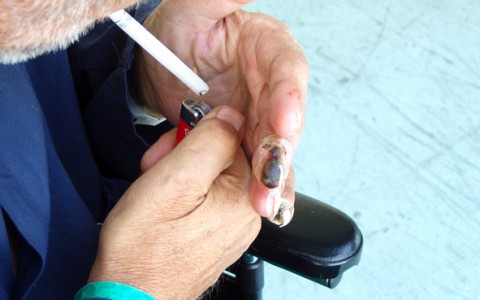Burger’s Disease, also known as thromboangitis obliterans, is a disease which causes the patient’s limbs to decay due to blood circulation impediment caused blood vessel blocked by flammatory transformation of blood vessels in arms and legs. The name comes from Leo Burger, who reported this disease in 1908. It is characterized by pain during rest, repeated ischemic ulcer and gangrene at the tips of hands and feet. It is only diagnosed by its clinical symptoms. Its cause and mechanism has not been revealed. However, in many of the cases, smoking is shown to be closely related to occurrence and progress of the disease.
The most common initial symptom is claudication at the hands and feet (pain caused by improper blood flow supply during movement), or severe pain at lower arms or legs during rest. As the disease progresses, the skin at the arms and legs affected by occlusion shows athropia, accompanied by ischemic ulcer, numbness and loss of sense. If the disease further progresses, tissue necrosis may occur at the affected arms or legs.
The only provided way to stop the progress of the disease and avoid amputation is to completely quit smoking. However, even if the patient quits smoking, stringhaltedness, Raynaud’s phenomenon and other symptoms may continue. Other treatments include the use of prostaglandin derivative which relaxes smooth muscle cells within blood vessels and inhibit their proliferation, and inhibits platelet aggregation to prevent thrombosis. This medicine, however, is known to cause side effects such as coldness, nausea, headache and diarrhea.
Other medications include vasodilator and anti-inflammatory drug, but none of them offer fundamental cure for Burger’s disease. As for surgery, one possible way is to bypass surgery which connects this side of the clogged blood vessel to the other side using the patient’s blood vessel to resume the clogged blood flow. However, bypass surgery is not applicable to Burger’s disease because the disease progresses from terminal vessels. When all of these treatments fail, there is no option left but to amputate the affected area.



Most Commented